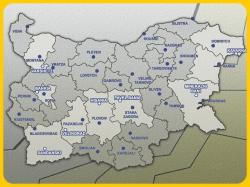|
| Bulgarian Mineral Springs |
|
|
 Bulgaria has got a huge reserve of mineral springs. Their total flow rate is said to exceed the volume of all bottled mineral waters worldwide.
Bulgaria has got a huge reserve of mineral springs. Their total flow rate is said to exceed the volume of all bottled mineral waters worldwide.
The mineral treasure of the Bulgarian lands was appreciated by the ancient Romans, who strewed the country with mineral baths and health spas. Some of the popular spa centres of the Roman antiquity were Augusta (present-day Hisaria), Pautalia (Kyustendil), Thermopolis (The Burgas Mineral Baths), Germanea (Sapareva Bania), Ulpia Serdica (Sofia), etc. The Bulgarian mineral waters boast various properties, and are good both for drinking and healing. Their temperature range varies from 25 to 100 degrees C. Bulgaria's hottest streams (101.4 degrees) are the geysers in Sapareva Bania, at the foot of Mount Rila. Bulgaria's curative waters are slightly or strongly mineralised, fresh or salty. They cover the entire spectrum of the known healing properties of mineral water. They can also be used for heating, although this practice has been poorly used for the time being.
What do we know today about the deposits of this liquid gold? Bulgaria has been found to have 225 mineral spring deposits with an estimated total flow rate of 5000 l./sec. The total annual volume of usable mineral water amounts to over 100 million m³. It is only 6% of these reserves that has been studied, claims Prof. Shterev, but they might be much more. Southern Bulgaria holds most of the deposits (148), while in Northern Bulgaria they are 77. The streams in Southern Bulgaria have been researched better, because the water there comes to the ground's surface. The streams in Northern Bulgaria can be reached by deep drilling alone. In the words of Prof. Shterev, Bulgaria is dramatically lagging behind with regard to mineral water utilization. A mere 6% of the potential of hot mineral springs has been revealed. According to him, they hide unsuspected opportunities for agriculture and social development as well as for boosting the development of 150 Bulgarian municipalities. It is proven that the mountain and coastal areas with mineral springs in Bulgaria have bioclimatic advantages over most wellness and spa centres in Northwest Europe, the Sudetes, the Carpathians, the Massif Central in France and even the Apennine Peninsula.
The Danubian Plain and the Ludogorie, loosely translated as the Region of Wild Forests, in Northern Bulgaria, have vast hot and salty reservoirs of Mesozoic and Paleozoic age. They cover an area of 20000 km³, being a gigantic accumulators of geothermal energy, claims Mr. Shterev. The most shallow and commercial of them spreads across some 8000 km³in the middle of the Danubian Plain and in two small regions near the towns of Vratsa and Vidin. The total volume of static water in it amounts to 200-220 billion m³.
Source: http://bnr.bg
|
| Monday, Nov 14, 2011 |
|
|
|
|
| » RENTALS |

|
|
|
| Office Space |
€ 46 |
|
| Location: |
Gorna Oryahovica |
|
|

|